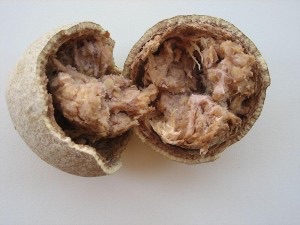 we used to get these in one of our 2 weekly shipments from sri lanka at Sheraton Maldives Full Moon Resort & Spa (OFFICIAL) very interesting for sure and the pulp choco-citrus flavours……i made the best wood-apple jelly for our breakfast buffet and bottled some for souvenir shop sales…..
we used to get these in one of our 2 weekly shipments from sri lanka at Sheraton Maldives Full Moon Resort & Spa (OFFICIAL) very interesting for sure and the pulp choco-citrus flavours……i made the best wood-apple jelly for our breakfast buffet and bottled some for souvenir shop sales…..
another name is elephant fruit and apparantly young elephants will play with a fruit for hours before swallowing it whole…….
aaanndd the fruit comes out the other end of the elephant with all of the insides of the fruit gone….with just a perfect round very hard empty shell of the fruit left (like a big brown ping-pong ball)….kids in sri lanka love to find one of these elephant processed fruits to play with……
lol…….elephant fruit!……
my wood-apple jelly was delicious and made from un-elephant-processed fruits…….they are obviously full of pectin……
thanks Anura Priyantha Bandara for info on the elephant fruit back at Sheraton Maldives Full Moon Resort & Spa (OFFICIAL) in 2004 before the tsunami came….
__________________________
The wood-apple:
is native and common in the wild in dry plains of India and Ceylon and cultivated along roads and edges of fields and occasionally in orchards. It is also frequently grown throughout Southeast Asia, in northern Malaya and on Penang Island. In India, the fruit was traditionally a “poor man’s food” until processing techniques were developed in the mid-1950’s.
The fruit is tested for maturity by dropping onto a hard surface from a height of 1 ft (30 cm). Immature fruits bounce, while mature fruits do not. After harvest, the fruit is kept in the sun for 2 weeks to fully ripen.
The rind must be cracked with a hammer. The scooped-out pulp, though sticky, is eaten raw with or without sugar, or is blended with coconut milk and palm-sugar sirup and drunk as a beverage, or frozen as an ice cream. It is also used in chutneys and for making jelly and jam. The jelly is purple and much like that made from black currants.
A bottled nectar is made by diluting the pulp with water, passing through a pulper to remove seeds and fiber, further diluting, straining, and pasteurizing. A clear juice for blending with other fruit juices, has been obtained by clarifying the nectar with Pectinol R-10. Pulp sweetened with sirup of cane or palm sugar, has been canned and sterilized. The pulp can be freeze-dried for future use but it has not been satisfactorily dried by other methods.

Recent Comments